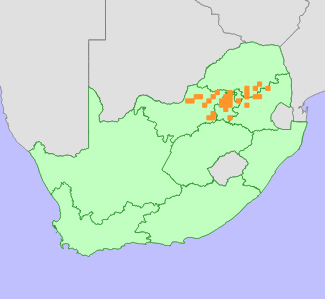|
Scientific Name | Aloe transvaalensis Kuntze |
Higher Classification | Monocotyledons |
Family | ASPHODELACEAE |
Synonyms | Aloe laxissima Reynolds |
National Status |
Status and Criteria | Least Concern |
Assessment Date | 2018/11/06 |
Assessor(s) | H. Mtshali |
Justification | Aloe transvaalensis is widespread, common and not in danger of extinction. |
Distribution |
Endemism | South African endemic |
Provincial distribution | Gauteng, Limpopo, Mpumalanga, North West |
Range | This species is endemic to northern South Africa, where it occurs from Zeerust in North West Province eastwards to Sekhukhuneland on the border between Mpumalanga and Limpopo provinces. |
Habitat and Ecology |
Major system | Terrestrial |
Major habitats | Grassland, Savanna |
Description | It occurs on rocky slopes, often at the foot of koppies, frequently between shrubs and bushes in grassland and savanna. |
Threats |
| Aloe transvaalensis is not threatened (Van Wyk and Smith 2014). |
Population |
This species is abundant, especially around Johannesburg and Pretoria (Van Wyk and Smith 2014). It is resilient to disturbance, and therefore no significant population decline is suspected.
|
Population trend | Stable |
Notes |
| Aloe transvaalensis was previously included in the synonymy of A. zebrina, but has been reinstated (Smith et al. 2012). |
Assessment History |
Taxon assessed |
Status and Criteria |
Citation/Red List version | | Aloe transvaalensis Kuntze | LC | 2020.1 | |
Bibliography |
Smith, G.F., Figueiredo, E., Klopper, R.R. and Crouch, N.R. 2012. Summer-flowering species of maculate Aloe L. (Asphodelaceae: Alooideae) in the Aloe zebrina-complex from South Africa: reinstatement of four names, and description of A. braamvanwykii Gideon F.Sm. & Figueiredo. Bradleya 30:155-166.
Van Wyk, B.-E. and Smith, G.F. 2014. Guide to the Aloes of South Africa. (Third ed.). Briza Publications, Pretoria.
|
Citation |
| Mtshali, H. 2018. Aloe transvaalensis Kuntze. National Assessment: Red List of South African Plants version 2024.1. Accessed on 2025/10/27 |
 Comment on this assessment
Comment on this assessment


